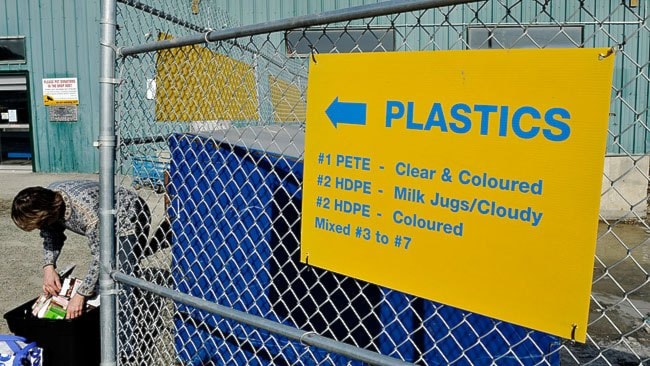A machine that can turn waste plastic into oil sounds like a miracle.
Our culture sees plastic as cheap and disposable, and oil as a scarce, precious commodity. It’s kind of like turning straw to gold.
But we’re thinking about it all wrong, according to Joy Snyder, executive director of Raven Recycling Society in Whitehorse.
A machine recently installed at P&M Recycling promises to take plastic out of our landfill and turn it into energy. But it distracts us from the bigger goals of waste management, said Snyder.
Disposing of plastic while recovering some of the energy trapped inside is better than leaving it in a landfill, but it’s not nearly as efficient as recycling, she said.
Everyone is familiar with the motto: reduce, reuse and recycle.
The fourth ‘R’ is recovery. That is the waste management term for disposing of waste while harnessing some of the energy trapped inside.
But there’s a hierarchy to the Rs, when it comes to best waste management practices.
To reduce is better than to reuse, which in turn is better than to recycle. Recovery comes in below that.
Why? Because the most energy-intensive part of making plastic comes from first exploring for and extracting oil, and second from processing that oil into material.
Recycling old plastic into new plastic takes much less energy than making it from scratch, so it makes sense to keep the plastic in circulation for as long as possible.
The argument for a plastic-to-oil machine is compelling. We need the oil anyhow, and we have the waste plastic material right here. If we didn’t turn the plastic into oil, we’d have to ship more oil in, so why not make it with the stuff we have on hand?
It sounds good, but the facts don’t back it up, according to Snyder.
Because turning oil into plastic is so energy intensive, it makes much more sense to use plastic as plastic, and oil for oil, she said.
What about the energy used in transportation? Isn’t plastic-to-oil a sort of 100-mile diet for energy?
It’s a myth that transportation is a significant energy cost to recycling, said Snyder.
She pointed to research by the Environmental Protection Agency that found shipping recyclables more than 3,000 kilometres still resulted in significant energy savings.
Here in the Yukon, we ship up more than we ship out, so Raven gets good rates on trucks that would be going back empty anyhow.
“We’re just hitchhiking and burning a bit more fuel because there’s a load on.”
According to a recent City of Whitehorse waste audit, eight per cent of what goes into our landfill is plastic.
Eleven per cent of the total waste the city produces is currently recycled. That number could be as high as 46 if we recycled everything possible.
A plastic-to-oil machine may deal with some of the plastic currently going to the landfill, but Snyder would rather see all of it get recycled. And that dream is not so far from reach, she said.
Raven Recycling is currently expanding their operations so they can deal with more materials - maybe as much as all of the plastics and other recyclables in the territory. But they need the government to create incentives for recycling, so that material comes to them and doesn’t end up in the landfill, said Snyder.
From an economic perspective, at least with a narrow view, the plastic-to-oil machine still wins out.
If it works the way manufacturers say, it will take plastic that would otherwise cost money to dump or recycle, and turn it into something that could be sold.
P&M Recycling has said that they expect to save $18,000 in heating costs over the one-year trial.
Recycling, on the other hand, costs more money than it generates.
Snyder estimates that she spends about $500,000 on equipment, labour and shipping to process about 800 tonnes of recycling every year. She makes back about $300,000 selling those materials to commodities markets Outside.
The society has to make up the balance through various commercial activities, including their bottle depot service and a few contracts with the government. The City of Whitehorse also provides a $50-a-tonne diversion credit.
Pointing to data carefully worked out on spreadsheets, Snyder suggested that if the city and the territory could keep all the recyclable material out of the landfill, it could all be processed at a cost that’s only minimally more than we’re spending now.
Raven Recycling is getting ready for it. They are currently installing new bins, where customers will only have to sort their material into glass, paper, containers, and cardboard. A conveyor belt system will allow employees to sort items efficiently, while a new automatic baler will get the products ready for shipping.
All of that should be up and running by mid-October. Then Snyder will just have to wait for the government to help bring the material to her.
The City of Whitehorse wants to have “zero waste,” meaning maximum reduction, reuse and recycling, by 2040. Snyder is getting tired of waiting.
“In 2040 I’ll be dead! What sort of a goal is that, man?”
Contact Jacqueline Ronson at
jronson@yukon-news.com
